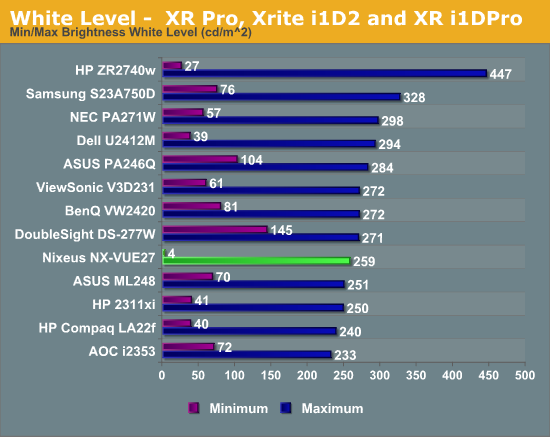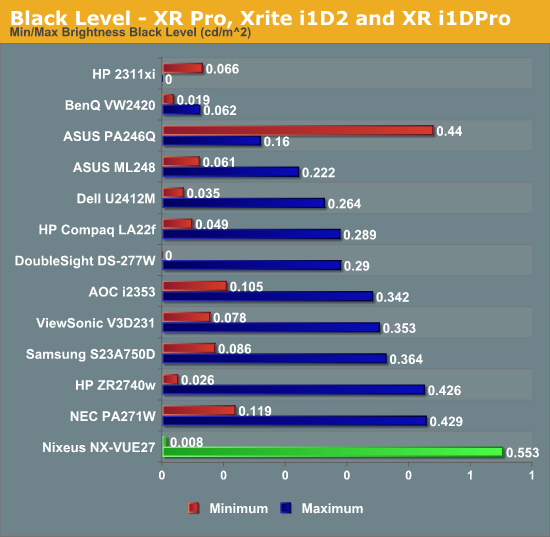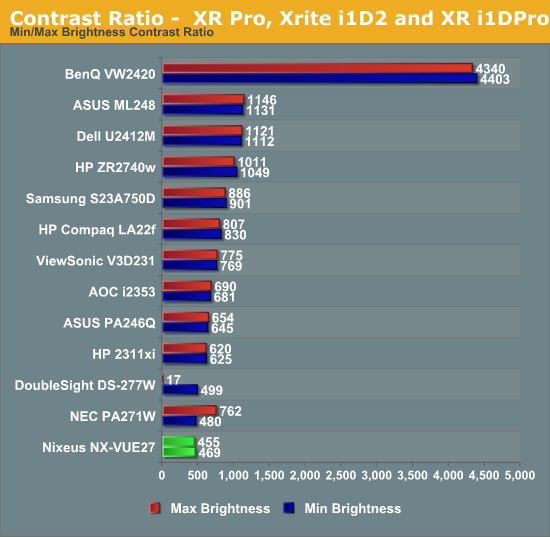Nixeus NX-VUE27 27" Monitor: High Resolution for the Masses
by Chris Heinonen on September 20, 2012 6:10 PM ESTBrightness and Contrast
For this review, I altered the way I measure brightness and contrast. With display vendors including dynamic modes that shut off the backlight completely on all-black screens, those can’t be used for testing anymore as it leads to infinite contrast ratios. Additionally it doesn’t do a real world, accurate test of what the real contrast and brightness levels would be. Instead I am now measuring the screen using a 5x5 ANSI contrast pattern, once regular and once reversed. This allows for getting a better idea of panel response, and it will reward companies that use better backlighting systems (like LED array systems) that have precise control, less backlight bleeding, or that move to a technology like OLED in the future.
The downside is that new results are not directly comparable to old results. It also doesn’t scale well from a large display to a smaller display, as the smaller targets on small displays mean you might more easily read light from another target. I would expect that numbers now will look a little worse than before because of the harder testing, and nowhere near the ridiculous numbers often quoted by vendors. It will provide better data for the readers, however, and so it is the way to move forward.

With the brightness set to maximum we get a white level in the center of the ANSI pattern of 259 nits. This is lower than I expected from the specs, but a full field white might be able to generate a brighter square as well. For the minimum white level I set the brightness level down to 20. With it set to 19 I could get a reading on white of around 1 nit, but black was below what the meter could read, and so I had to set it up to 20. Set here, I had 3.8 nits of light output (which is rounded up to 4 in the chart). Some displays only get down to 70-80 nits, which might be brighter than some users want, so this is a good number to see. I just wish the brightness control functioned all the way down to 0 to provide better control of the backlight overall.

The black level of the Nixeus with the backlight set to maximum is 0.553. This seems high, but this is our first pass with the new ANSI testing method, so we will have to see if this winds up being high or low after a couple more reviews. The black level of the Nixeus with the brightness at 20 is 0.008 nits, which is quite low. It’s really as low as we’ve measured before, but this is somewhat a result of a backlight that stops being functional below this setting.

The resulting contrast ratios here are 469:1 at maximum and 455:1 at minimum. These unfortunately come in at the bottom of the list for 27” monitors--and really it's the bottom of the chart for all the monitors we have reviewed recently. Getting good contrast ratios becomes harder as the display gets larger, and the backlighting systems to really pull them off become more expensive. I think we are almost stuck with these lower contrast ratios until we start to see more screen innovations, like OLED or backlit-LED array displays, but those are also very expensive. I’m not too happy about the sub-500:1 number as dynamic range is very important in a display, but it’s a compromise you’ll have to weigh yourself.










66 Comments
View All Comments
magreen - Thursday, September 20, 2012 - link
Especially given that there appears to be a real surplus of compute power in computers these days. The vast majority of users have no need for the compute power an i7 can deliver nor what most discrete GPUs can deliver. It's time to harness that power to finally give us resolution independent displays!peterfares - Thursday, September 20, 2012 - link
Windows fully supports DPI scaling since Vista. Most Microsoft programs fully support it and a few third party ones do, too. You can also try forcing high DPI mode on unsupported programs and see which ones work. Otherwise you can run them at their original pixel size or you can pixel scale them.Microsoft made a small push for higher DPI screens back during Vista's launch (along with hybrid hard drives) and it's only now when screens are finally moving up in DPI (look at the new laptops and tablets with 13" 1080p screens). Hybrid hard drives are also coming into play, though it's a bit late since SSDs are becoming big and cheap enough to completely replace them. Vista was just far ahead of its time.
cosmotic - Friday, September 21, 2012 - link
"vista was just far ahead of its time"Yeah, *thats* what vista was.
Malphas - Monday, September 24, 2012 - link
Actually it was, try Vista again today and you'll find it a near identical experience to Windows 7. The reason it was so awful at the time was due to underpowered hardware (made worse by the Vista Ready scheme Microsoft stupidly went along with to appease OEMs), incompatible hardware and software, buggy third party drivers, software that didn't play nice with UAC, etc. The actual OS itself is sound and again only cosmetically different from Windows 7, which received near universal praise.Penti - Friday, September 21, 2012 - link
Readyboost is still horrible and should die, seriously just give me an mSATA SSD + HDD if cheap storage is needed instead of 5400 rpm drives and small sub 64GB SSDs for caching. It's worse then a fast HDD. DPI-scaling is by no means an nice and clean way of scaling elements in Windows, not even all Microsoft apps support it. Though it's standard to have it scale on OEM-PCs since a long time now. Metro still scales horrible though.madmilk - Thursday, September 27, 2012 - link
It supports it in basically the same way the retina Macbook does (assuming Vista-style scaling): show natively high-res apps at full resolution, and scale up the rest.The difference is, Microsoft hasn't gone out and made noise about it, so pretty much everyone's apps are just using ugly scaling.
Sabresiberian - Friday, September 21, 2012 - link
"Resolution" has been perverted since LCDs came out. It used to be tied to pixel density. So, correctly speaking cell phones already have higher resolutions than monitors.;)
jeremyshaw - Thursday, September 20, 2012 - link
Hello,I've noticed you mentioned HDMI 1.4 support in the specifications list. Does that mean an AMD GCN or Intel Ivy Bridge (do the Ivy Bridge drivers support that, yet?) can output, via a HDMI output, a 2560x**** image at 60Hz?
peterfares - Thursday, September 20, 2012 - link
It's been stated that this display supports those resolutions over HDMI as long as you have a device capable of sourcing it. I don't know what can source it, if anything, yet.atotroadkill - Thursday, September 20, 2012 - link
From what I can find on the web, if you are using the CPU's embedded GPU for the HDMI output then no - only displayport can.To power 2560x1440 over HDMI you may need a descrete Nvidia 600 series card.